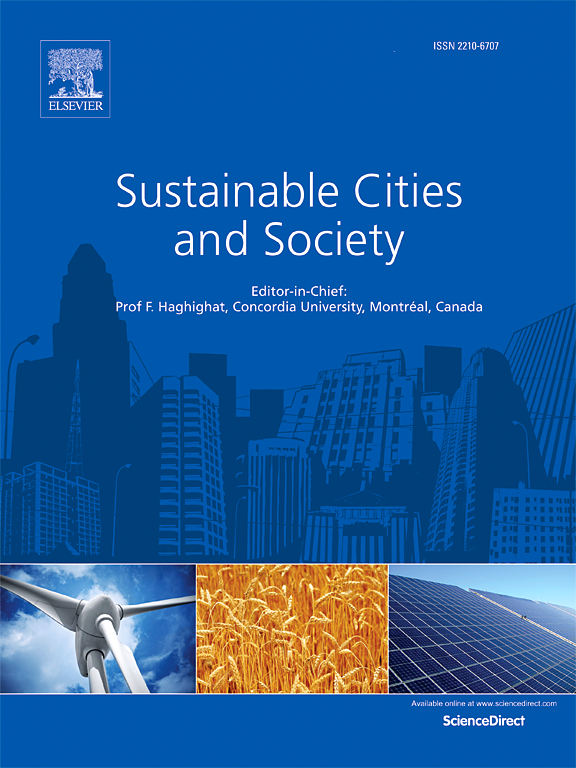考虑变量交互和异质性的数字化和人工智能对碳排放的影响:一个可解释的深度学习建模框架
IF 10.5
1区 工程技术
Q1 CONSTRUCTION & BUILDING TECHNOLOGY
引用次数: 0
摘要
随着人们对数字化和人工智能(D&;AI)的日益关注,解释它们对城市碳排放的影响变得至关重要。本研究提出了一个考虑变量特征交互和异质性的可解释深度学习建模框架,以探索人工智能的碳影响。随机森林(Random Forest, RF)用于探索变量重要性和优化模型参数,然后构建Decision Deep &;交叉特征变换网络(DDCFTN)拟合精度高。SHapley加性解释(SHAP)和因果推理用于解释变量效应和异质性。使用中国275个城市(2000-2021)的数据,DDCFTN优于传统的统计或机器学习模型(RMSE=579.88, MAE=440.91, Radj2=0.994)。主要发现包括:1)人工智能对碳排放的贡献被低估,交互效应使碳影响增加了665.569%。2)分阶段的相互作用模式:数字化初期抑制人工智能相关排放(-34.017% ~ -96.361%),后期又增强人工智能相关排放(13.191% ~ 45.353%)。3)存在不对称的相互作用,人工智能对数字化排放的影响达到峰值,仅为0.119%,由于反向监管效应,呈倒u型趋势。4)城市特征(如区位条件和城市规模)通过连锁反应重塑D&;AI排放的异质性,作为关键的先决条件。本研究为解释人工智能的碳影响和指导城市脱碳政策提供了一种新的分析范式。本文章由计算机程序翻译,如有差异,请以英文原文为准。
Impact of Digitization and Artificial Intelligence on Carbon Emissions Considering Variable Interaction and Heterogeneity: An Interpretable Deep Learning Modeling Framework
With growing attention on digitization and artificial intelligence (D&AI), interpreting their impact on urban carbon emissions has become critical. This study proposes an interpretable deep learning modeling framework considering variable feature interaction and heterogeneity to explore D&AI's carbon impacts. Random Forest (RF) is used to explore variable importance and optimize model parameters, followed by constructing a Decision Deep & Cross Feature-Transformation Network (DDCFTN) for high-fitting accuracy. SHapley Additive exPlanations (SHAP) and causal inference are employed to interpret variable effects and heterogeneity. Using data from 275 Chinese cities (2000–2021), DDCFTN outperforms traditional statistical or machine learning models (RMSE=579.88, MAE=440.91, =0.994). Key findings include: 1) D&AI's contribution to carbon emissions is underestimated—interactive effects increase the carbon impact by 665.569%. 2) Staged interaction patterns are observed: Digitization initially suppresses AI-related emissions (-34.017% to -96.361%) but later enhances them (13.191% to 45.353%). 3) Asymmetrical interactions exist, with AI's impact on digitization's emissions peaking at just 0.119%, following an inverted U-shaped trend due to retro-regulation effects. 4) City characteristics (e.g., Location Conditions and Urban Scale) reshape the heterogeneity of D&AI emissions through chain reactions, acting as key antecedents. This study introduces a novel analytical paradigm for interpreting D&AI's carbon impact and guiding urban decarbonization policies.
求助全文
通过发布文献求助,成功后即可免费获取论文全文。
去求助
来源期刊

Sustainable Cities and Society
Social Sciences-Geography, Planning and Development
CiteScore
22.00
自引率
13.70%
发文量
810
审稿时长
27 days
期刊介绍:
Sustainable Cities and Society (SCS) is an international journal that focuses on fundamental and applied research to promote environmentally sustainable and socially resilient cities. The journal welcomes cross-cutting, multi-disciplinary research in various areas, including:
1. Smart cities and resilient environments;
2. Alternative/clean energy sources, energy distribution, distributed energy generation, and energy demand reduction/management;
3. Monitoring and improving air quality in built environment and cities (e.g., healthy built environment and air quality management);
4. Energy efficient, low/zero carbon, and green buildings/communities;
5. Climate change mitigation and adaptation in urban environments;
6. Green infrastructure and BMPs;
7. Environmental Footprint accounting and management;
8. Urban agriculture and forestry;
9. ICT, smart grid and intelligent infrastructure;
10. Urban design/planning, regulations, legislation, certification, economics, and policy;
11. Social aspects, impacts and resiliency of cities;
12. Behavior monitoring, analysis and change within urban communities;
13. Health monitoring and improvement;
14. Nexus issues related to sustainable cities and societies;
15. Smart city governance;
16. Decision Support Systems for trade-off and uncertainty analysis for improved management of cities and society;
17. Big data, machine learning, and artificial intelligence applications and case studies;
18. Critical infrastructure protection, including security, privacy, forensics, and reliability issues of cyber-physical systems.
19. Water footprint reduction and urban water distribution, harvesting, treatment, reuse and management;
20. Waste reduction and recycling;
21. Wastewater collection, treatment and recycling;
22. Smart, clean and healthy transportation systems and infrastructure;
 求助内容:
求助内容: 应助结果提醒方式:
应助结果提醒方式:


